Point of Beginning Mx. Science
Estimated time to follow this cut: minutes
This is one of three tracks alongside which you can explore how ethical knowledge conciliation may come to matter within community-based polar bear research through aesthetic action. In this case the performative presence of Mx. Science.
This particular aesthetic action was informed by the practices and insights that emerged from the other two tracks: community-based co-creative filmmaking, and the organization of the final BearWatch (pre-)workshops. Its performance practice diffractively cuts across two events: the final BearWatch (pre-)workshop in Gjoa Haven, and the Annual Science Meeting (ASM), a large conference gathering that connects researchers and scientists from across the Circumpolar Arctic.
Mx. Science
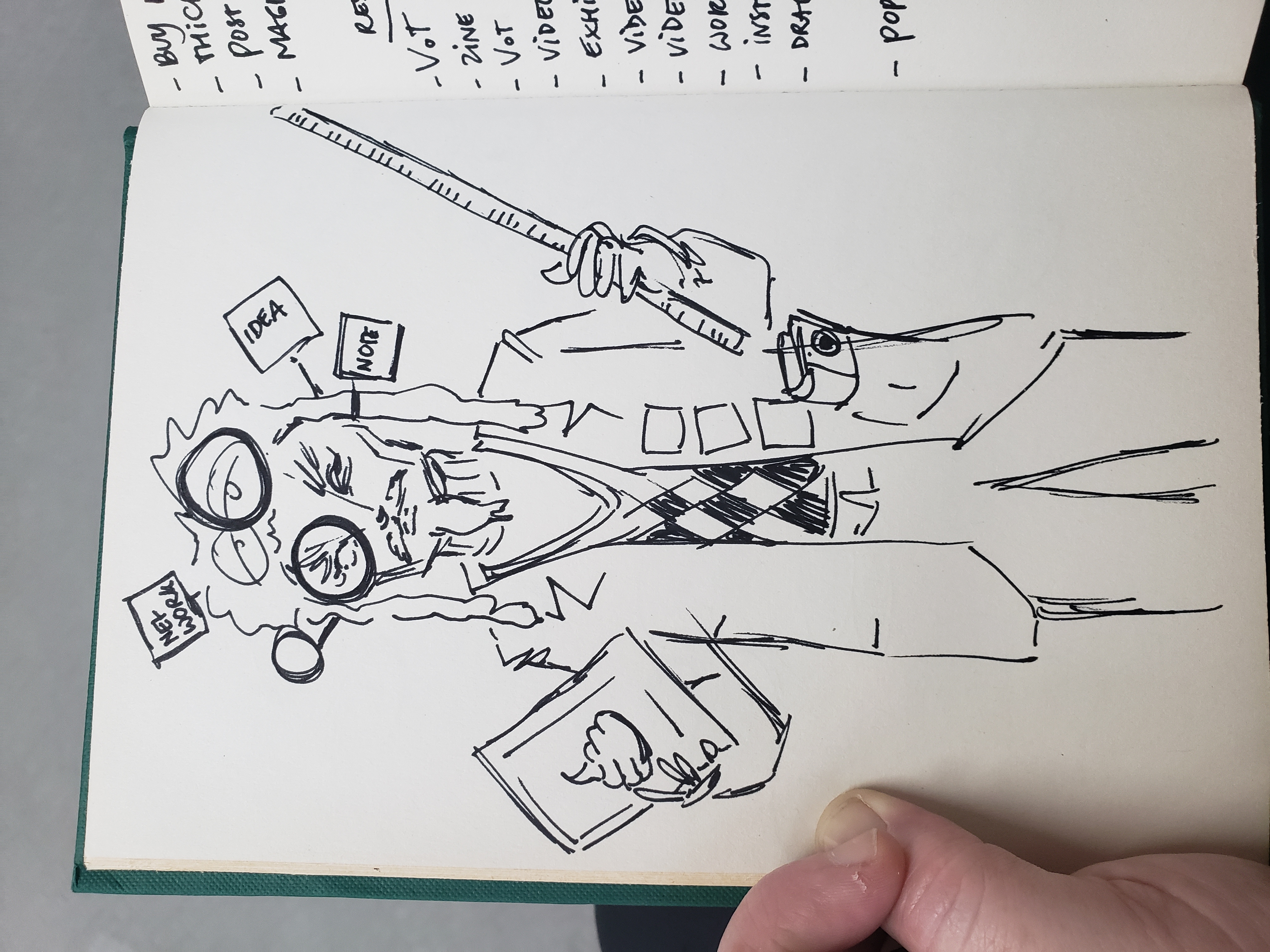
"Mx. Science", is a situated, playful, reconfigurative invitation to reimagine (a) scien/ce/tist, performed by me.
As Mx. Science, I practice (my) research while displaying various (in)determinate signifiers. Some of these allow me to be categorized- for example as a scientists/researcher (wearing a laboratory-coat, and safety glasses, referring to sciences that conduct laboratory experiments, while also wearing various lenses and a carrying a clipboard for notes, that signal towards disciplines like anthropology, or geography). Other ways of presenting, however, defy categorization. Mx. Science is for example not determinately human (blue-skinned), or cis-gendered (for example, tonal qualities of my voice that are dissonant with gendered presentations like facial hair).
Mx. Science is performed by me, a non-Inuit researcher conducting research from a western educational institute and as part of the BearWatch team. The performance can therefore not be seen as an intervention: a movement from the outside-in. Neither can my use of make-up and choice of clothing and attributes be understood as fitting fully "inside" the social contracts of the spaces within which I have introduced Mx. Science. Mx. science is therefore rather a diffractive event, proposed from the liminal.
Acting from such a liminal space, I made sure to receive explicit sanction and input from the BearWatch PI's, as well as community-partners, representatives and participants.
First introductions
I had first introduced Mx. Science to the school in Coral Harbour, by invitation of the grade four teacher and with permission from the school principle. Mx. Science, being a very colourful and playful character was received positively by the school, students and teachers. Although no formal data was collected, I received informal feedback from the teacher and principle that my presence was very much enjoyed by multiple people in the school, and that there was expressed desire for me to return to the school.
After this brief but positive experience in Coral Harbour, I introduced Mx. Science during the second day of the pre-workshop in Gjoa Haven, to discuss its potential and the desirability of introducing a playful element into an important gathering. Again, the persona was very positively received, and the decision was made with sanction from the Gjoa Haven HTA, the BearWatch PI's and the participants of the pre-workshop to host the final gathering as Mx. Science.
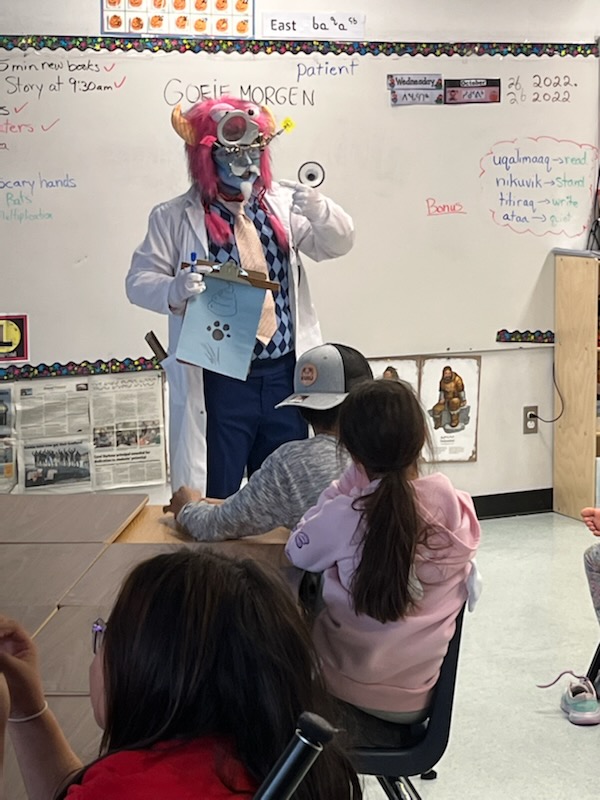
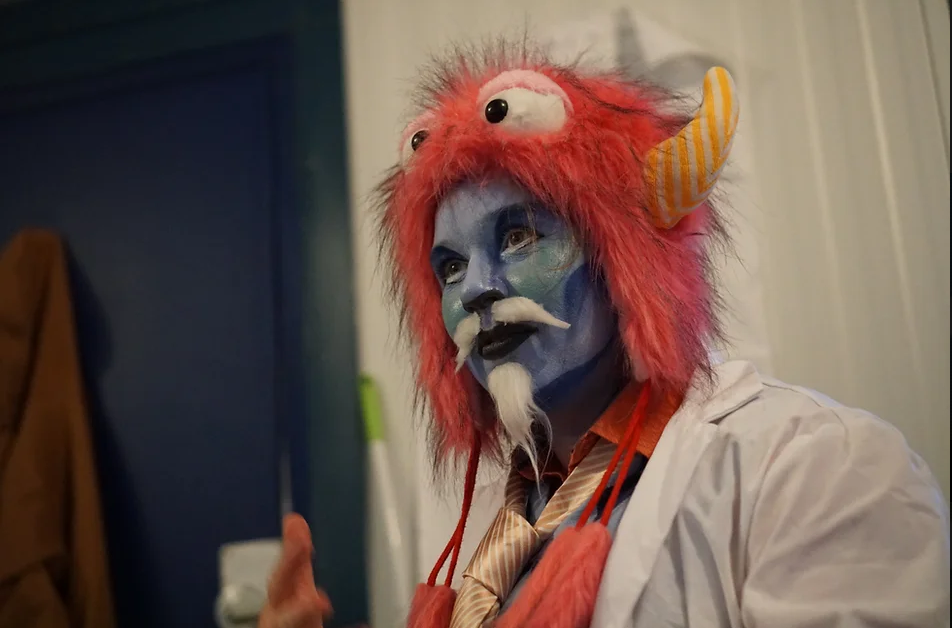
Return to Cut 3: "Wayfaring the BW Project"
The Liminal Scientist
By presenting a liminal figure of "the scientist", it becomes possible to query science and scientists themselves as a phenomenon that includes boundaries and properties. This in turn makes it possible to explore all the im/possible ways of being "different" within such a phenomena.
"Mx. Science" invites non-indigenous researchers (including myself) to rethink and reflect on their presence and the positions they take up in different contexts. As a figure that can unsettle taken for granted terms of engagements in multiple ways, Mx. Science holds the potential to open up a liminal space within which new relationships can be sensed or "felt" out, and provoke conversations about how we encounter each other across our differences. As a situated performance it is both an exercise in new ways of engaging each other through genuine curiosity, as well as an effective tool to que(e)ry where and when differentiated bodies dis/connect in space.
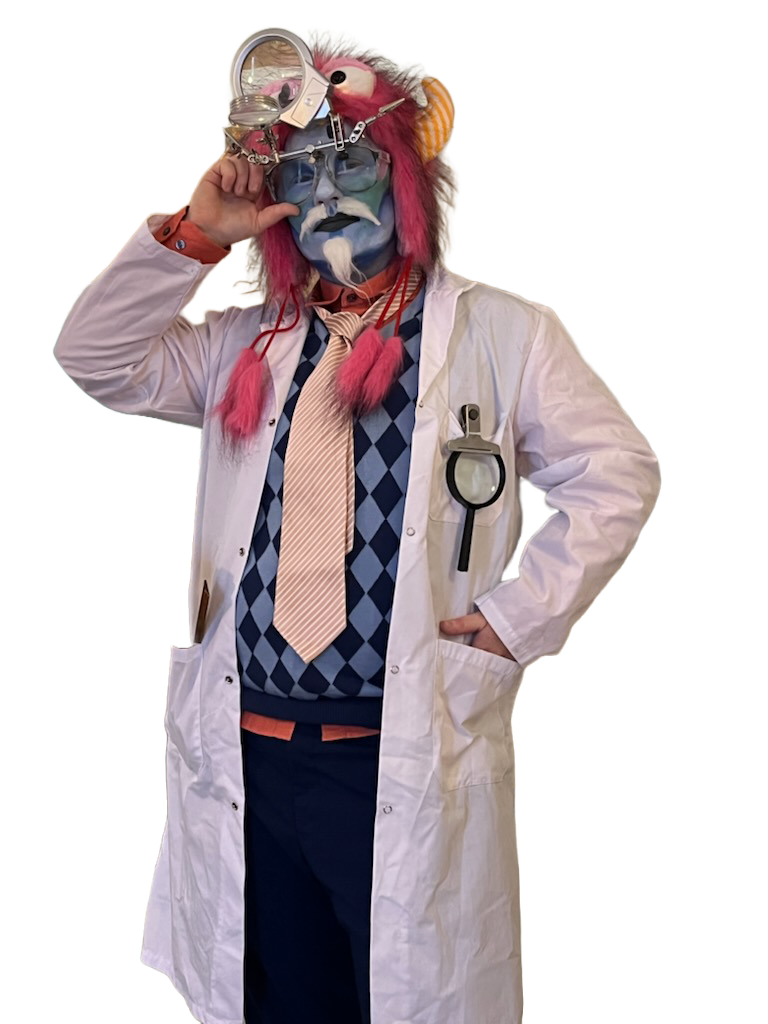
Drag as a Diffractive Method
The creation of Mx. Science, as a method, draws from my practice as a dragking (classically defined as a male-impersonator). As a performer, I explore non-binary, female, and more-than-human masculinities, and am part of a relatively recent revival of drag’-kings’, ‘-quings’ and ‘-things’ across the "global North". This generation of (club-)performers can be understood to have in common, a politically informed stage, or nightlife practice, that undoes, or "bends" traditional, western categorical understandings of gender, sex and family through queer kinship structures.
The techniques employed within drag to que(e)ry, perform, undo or bend boundaries and categories like the ‘natural’ and the ‘human’ can also be directly applied towards questions around the social ecologies of environmental research and management.
Arctic ‘wildernesses’, for example, can be seen as sites for the enactment of a specific hetero masculinity associated with physical strength, roughness, ingenuity, and self-realization (Sandilands & Ericson, 2010). Such sites of enactment (can) extend into scientific spaces, like laboratories or lecture rooms, reproducing hegemonic masculinities and perpetuating racial and gender inequalities and unequal power relations (MacGregor & Seymour, 2017). Drag has the potential to de-naturalize and unsettle such masculinities by embodying its technologies as separable from sex. Such masculinity, as performed through drag then becomes liminal, a place beyond categories – a space of play; ‘the betwixt and between’ through which shape-shifting figures turn things on their heads and pass on their way from one state of being to another (Rosenfeld, 2003). Taking these techniques and applying them not so much towards normative categories of gender, but towards norms upheld within western scientific spaces, opens our understanding of its conventions and social contracts in similar ways. Drag can thus, shift fixed positions, and transform everyday expectations and habits, that allows us to not to conduct transformative research – but also transform the researcher itself.
Annual Scientific Meeting Mx. Science
To better understand the possibilities Mx. Science enables to imagine ethical encounter outside of its conventional institutional structures, I had asked and gained permission from the organizers the Annual Scientific Meeting (ASM), also known as the ArticNet Conference in Toronto, in December 2022 - to attend as Mx. Science, directly after the final workshops in Nunavut.
I had informed the organizers that I would only be present, and did not require a stage or a timeslot as Mx. Science. During the 3-day conference, I attended as Mx. Science, and observed how people responded to me, as I moved through the conference space.
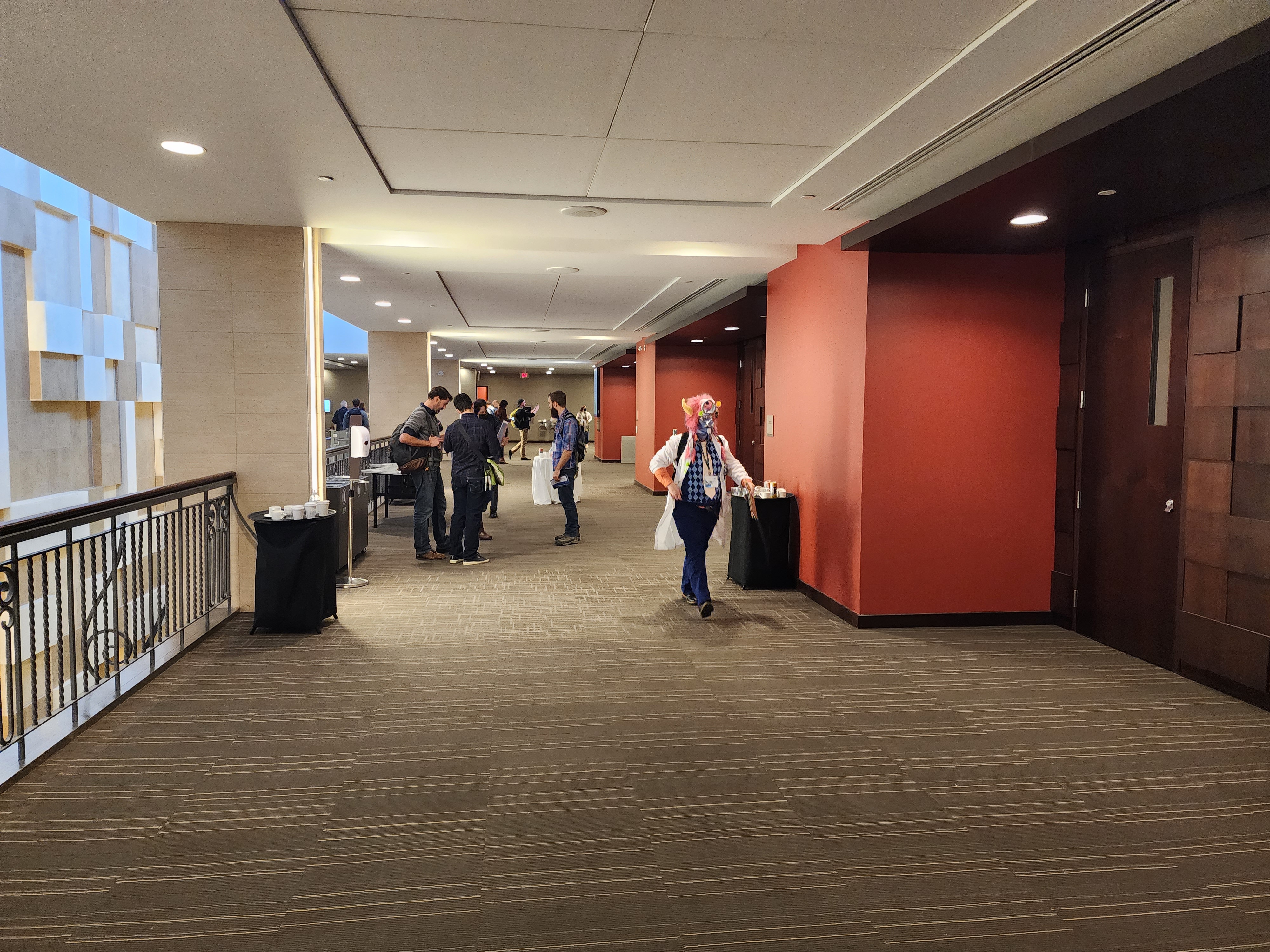
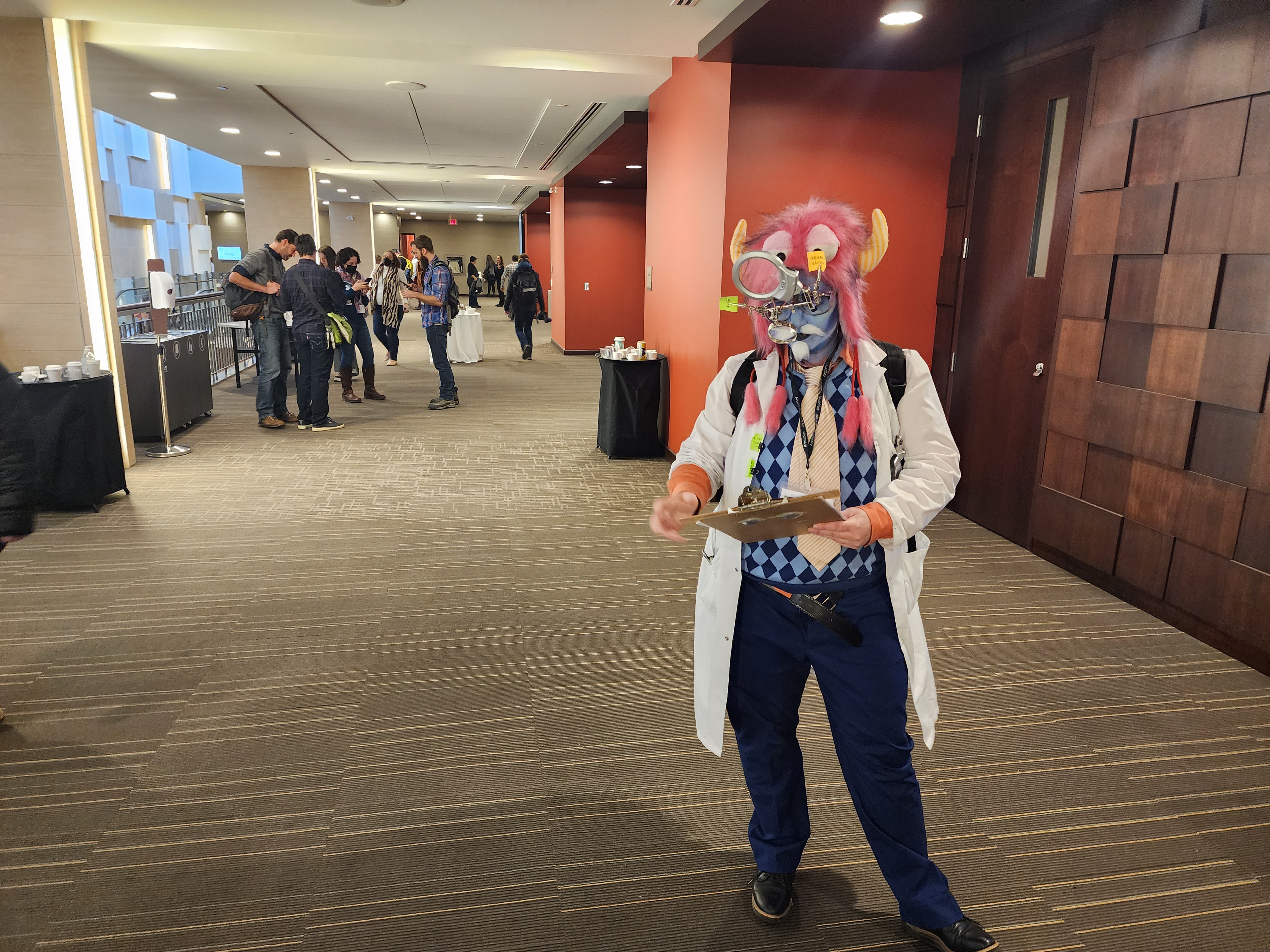
The Liminal and the Ethical Space
How do we determine who is a scientist? How do we meet each other in "scientific" spaces? What are the markers of inclusion, where lie the boundaries, and how do we recognize each other?
At the Annual Science Meeting in Toronto in December 2022, I was not often immediately recognized as a researcher or a scientist. Some attendees thought I was a performing some kind of mythical creature. Other associated me with the "smurfs". The lack of determinable signifiers prompted explorative questions like: are you wearing a costume? Is this a mask? Others were more explicit with their uncertainty: "I feel like I am walking into a minefield, how do I refer to you? Are you a persona? A character? I haven't kept up...", as if my presence was meant to perform a test of their use of language.
For others, there was some relief, when they could mark me as an "insider" through my official conference nametag (One side displayed my name and institutional affiliation in print, the other side displayed "Mx. Science in my own handwriting). Such marking as an "insider", was often immediately followed up with questions of my underlying research, my methodology or "what" my presence was supposed to represent. When the request for a re-presentative answer, or clear underlying message about science or scientists, remained unaccommodated, the moment of relief was replaced with various degrees of discomfort.
Explaining that Mx. Science becomes meaningful within encounters like the one we were engaging in then sparked for many a curiosity to explore - a trajectory that was often engaged through the form of a follow-up interview after the conference. Each of these interviews was semi-structured around three questions, how did Mx. Science affect you? Do you think Mx. Science was representative of something? What do you think Mx. Science was practicing at the conference? The ensuing conversations indicated that Mx. Science performed a very different material-discursive practice for each person that engaged with them. Whether this practice related to how we engage with the "other" during our research, how we take up space in settler-Indigenous context, or what (unexamined) standards of representability we uphold in scientific spaces.
Landmark: "The Great White Beast"
Another Point of Beginning
You have reached "Another Point of Beginning". These are not conclusive endings to my research, but rather perform at the cusp of emergence: They are a story so-far. Some of these points mark the end of funding cycles or project activities. Or they mark the limitations and scope of this particular PhD dissertation. Others are trails, and tracks that have faded out, as they remained un-revisited. They however always mark one moment along an ongoing animate line of correspondence between multiple agencies, and they usually allow for continuing with another cut.
This is where we take account for our journey so far. This journey is always partial, and so are the insights we have built on our way. You can trace the path you have taken through this Knowledge-Land-Scape by clicking the "trace" bar in the upper left corner of your screen. It will allow you to account for some of the insights that your journey has given you. The map below shows you the full extent of wayfaring possibilities of the scape.
Beyond the Cut
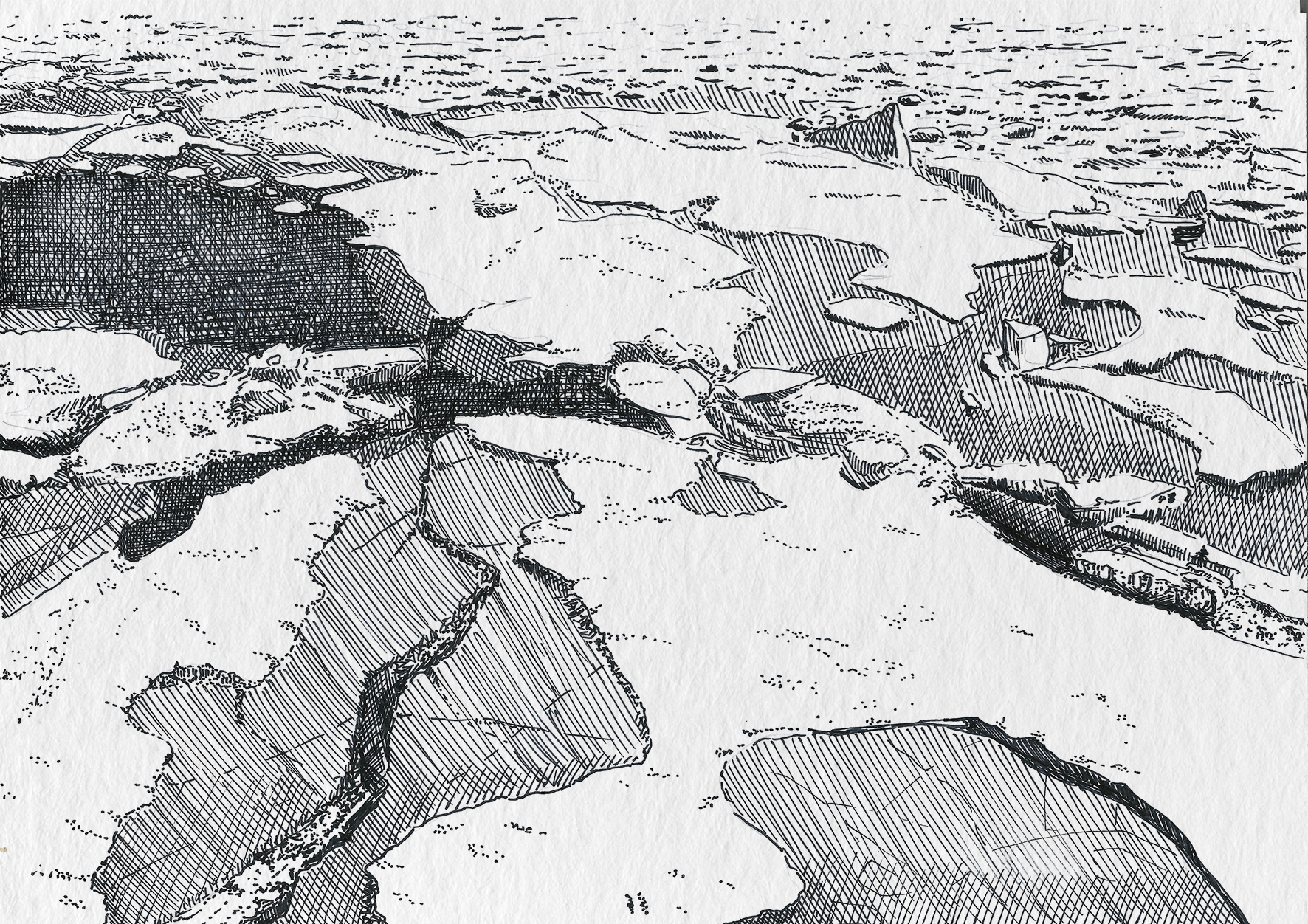
Through my interventions with Mx. Science I have gained an interest in what can be done through self-directed work of un-learning, decentering- and decolonizing the western scientist in cross-cultural contexts. For transformative practices to come to fruition, such un/learning should happen both by accepting leadership and practicing respectful collaboration with non-western partners, as well as through a self-initiated repositioning.
To explore the future possibilities of drag and performance art to decolonize, and unsettle scientific conventions within its own institutional spaces I have organized a workshop at the Descartes Institute of Science and Technology Studies at Utrecht University in 2024.
In February 2025, I was invited to attend a three-day general assembly meeting of a EU-funded Horizon 2020 research project as Mx. Science.
In April 2025 I will start an eight month fellowship with the Arctic Governance Research Group of the RIFS Institute in Potsdam to explore the diffractive possibilities Mx. Science offers within the scientific institute.
Detour to Cut 1: Cut 1 Voices of Thunder
